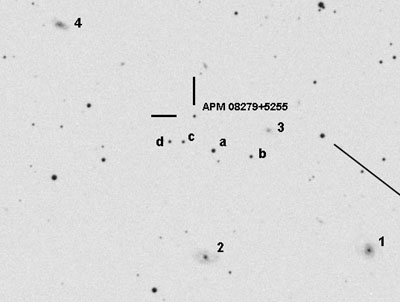exotic
January / February

home Jan/Feb March/April Mai/June July/Aug Sep/Oct Nov/Dec
|
exotic January / February |
 |
RA 08 - 12
Finder charts for all January/February objects as pdf file
Finder charts for ALL exotic objects as pdf file
 Finder chart by Stathis Kafalis visual magnitudes (nomad): a mag 14.9, b mag 16.5, c mag 16.1, d mag 16.8 |
APM 08279+5255 12 billion years old light from a lensed quasar in Lynx 08 31 42 +52 45 17 APM 08279+5255 is a quasar with a red shift of z = 3.91, corresponding to a light travel time of about 12 billion years, and is placed therefore "at the edge of the universe". The quasar is the active nucleus of a giant elliptic galaxy, driven by a black hole of estimated 23 billion solar masses. The brightness of the quasar is given by mag 15.2 (red) and 16.2 (vis, Nomad), the visual estimates according to observing reports by Achim Strnad and Stathis Kafalis are mag 15.6 and slightly brighter than 17.0, respectively. With my 22", the quasar was visible about 30% of the time by averted vision at the right location, not too far from single-photon detection :-). Actually, this should be a boring object, not much to see except for a tiny spec of light. It becomes fascinating only by knowing that these few photons have traveled 12 billion years. When the actually started their journey, the universe had only 12% of its current age. Cool, isn't it?
|
|
Nikolaus Sulzenauer http://quarks.maynau.com |
Frosty Leo An "icy" protoplanetary nebula in Leo 09 39 54 +11 58 52 Frosty Leo (IRAS 09371+1212) is a protoplanetary nebula, i.e. a precursor to a planetary nebula. Such nebula are not yet ionized as their central stars are not sufficiently yet. Besides its interesting symmetry (point-symmetry but no axial symmetry), spectra of this proto PN revealed the signature of crystalline ice. At the telescope, this proto PN is visible at 550x as a tiny elliptical disk, that is elongated in NW/SE direction. In rare moments of excellent seeing, a hint of the division of the bilobal structure was visible, that is shown in the HST image to the left. Some proto PN show considerable polarization of their emission. Such an effect was not visible with Frosty Leo. Using a polarization filter, the intensity remained roughly constant when rotating the filter. Web page of Bernd Gährken with his observations of Frosty Leo. More about proto PN is here and here.
|
|
Sextans B An irregular galaxy at the edge of the Local Group 10 00 00 +05 19 53
Sextans B is at a distance of roughly 4.5 billion LY and hence at the edge of our Local Group. Despite its integral brightness of mag 11.9, the surface brightness of this galaxy is quite low and the galaxy is furthermore lacking a prominent nucleus.
At the eyepiece of my 22" Dob, this galaxy is still relatively well visible and appears as a faint, but distinct structureless glow. Neighboring Sextans A is quite a bit more difficult to see.
In Sextans B, there is a globular cluster that is marked in the inverted image to the left (mouse over). |
|
|
click for finder chart |
Double Quasar General relativity live: a gravitationally lensed quasar 10 01 21 +55 53 57
The double quasar QSO 0957+561A/B can be found about 10 arcminutes NNW of the bright galaxy NGC 3079 and can be reached starting there by a relatively easy star hop. The quasar has a red shift of z=1.39, corresponding to a distance of 3.7 billion LYs. The two "objects" are two images of one and the same quasar separated by 6 arcseconds by gravitational lensing. Both images are about mag 17. Interestingly, the light of the two images has travel times that differ by 417 days, as revealed by the intrinsic variability of the quasi-stellar object. The quasar itself is not particularly difficult with 22" aperture. The problem is separating the two images. 6 arcseconds sounds like a lot, but it isn't when the two objects are very faint and indirect vision is required for seeing them. During several observations, I could see the quasar always with certainty using averted vision, but I could never split the images cleanly. For a clean split, the conditions likely have to be perfect at that aperture. |
|
|
Leo II An extremely faint companion to our Milky Way 11 13 29 +22 09 12
This is the little sister galaxy to Leo I, the dwarf galaxy just north of Regulus. Leo II is at a distance of roughly 750 000 LYs and is quite a bit fainter than Leo I. Its visibility mostly depends on the transparency of the sky. If Leo I appears difficult at the eyepiece, Leo is likely not visible at all. I have observed Leo II with my 22" Dob during a very transparent winter night in the southern Black Forest. During this night, Leo I was a distinct object that was clearly defined against the background. If you happen to have such excellent conditions, you should give Leo II a try as well. At the eyepiece, Leo II appeared as a small, extremely faint glow around a mag 14 foreground star. The galaxy is both fainter and smaller than Leo I. On the other hand, there is no disturbing star such as Regulus in the immediate neighborhood. |
|
Hickson 56 A galaxy chain next to NGC 3718 in Ursa Major 11 32 32 +52 57 00
Hickson 56 is a prototype of the tighter Hickson groups. This group is easy to find close to the interestingly shaped galaxy NGC 3718 at the southern edge of the bowl of the Big Dipper. Even with medium sized telescopes, the chain can be discerned, albeit component a will not be visible. With my 14" Dob, the chain was well visible, but could hardly be resolved into single galaxies. Every once in a while, single knots could be spotted, while it was difficult to nail down their precise location within the chain. With 22" aperture, the chain was relatively well resolved into three knots, consisting of components b, c/d and e, the latter being somewhat offset. At some moments, even c and d could be resolved as single galaxies. Unexpectedly, component a is the most difficult and appeared only indirectly as an elongated tiny patch without distinct brightening to the middle. At the eyepiece, a appears therefore considerably weaker as to be expected from the DSS image. |
|
|
Hickson 57 / Copeland's Septet A galaxy group in Leo with actually eight members 11 37 51 +21 59 00
Copeland's Septet is one of the showpieces of the Hickson catalog and quite a bit easier to observer as compared with Seyfert's Sextet. HCG 57 consists of two rows of galaxies of a length of roughly 3 arcminutes, comprising each three components, with the faint member g being a bit offset. The brightest component a is NGC 3753, and the other members (except h) bear NGC designation. With 14", the separation into two sub groups was obvious with a hint of resolution into fleeting single galaxies, which was, however, difficult to nail down. With 22", seven out of eight galaxies could be resolved, with h being out of reach. The single galaxies could be separated relatively easily using powers of 450x and indirect vision.
|
|
|
Abell 1367 Leo 1 galaxy cluster 11 44 30 +19 50 21
Abell 1367 is one of the brighter galaxy clusters of the Abell catalog. Quite a number of galaxies are mag 12 to 13, such that already with medium sized telescopes can show you more than 20 galaxies.
|
image credit: DSS
![]()
home Jan/Feb March/April Mai/June July/Aug Sep/Oct Nov/Dec